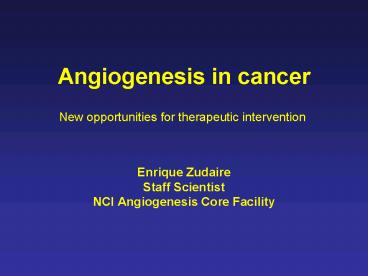Angiogenesis in cancer - PowerPoint PPT Presentation
1 / 31
Title: Angiogenesis in cancer
1
Angiogenesis in cancer
New opportunities for therapeutic intervention
- Enrique Zudaire
- Staff Scientist
- NCI Angiogenesis Core Facility
2
Vasculogenesis vs Angiogenesis Formation of blood
vessels from differentiating angioblasts and
their organization into a primordial vascular
network, consisting of the major blood vessels of
the embryo
Merks, Perryn, Shirinifard, Glazier, PLoS
Computational Biology 2008, in press.
Dijke Arthur Nat Rev Mol Cell Biol 8, 857
3
ANGIOGENESIS Physiological angiogenesis
Embryogenesis Female reproductive
systemDevelopment of folliclesCorpus luteum
formationEmbryo implantation Successful wound
healingPathological angiogenesisInhibition of
angiogenesisHemangiomas Psoriasis Kaposi's
sarcoma Ocular neovascularization Rheumatoid
arthritis Endometriosis Atherosclerosis Tumor
growth and metastasisStimulation of
angiogenesis Myocardial ischemia Peripheral
ischemia Cerebral ischemia Wound healing
Reconstructive surgery Ulcer healing
4
Progression of CancerAfter initiation and
promotion, a small tumor switches on angiogenesis
to become a large tumor.
5
The tumor microenvironment. Angiogensis
switches on AM, bFGF, MCP-1 and VEGF.
Angiogenesis switch
Tumor Growth
VEGF, AM, bFGF, MCP-1 gradient
6
VEGF receptors
7
The balance hypothesis for the angiogenic switch.
Activators include VEGF family, FGF family,
PDGF, TGF family, AngiogeninAngiopoietin-1/Tie2,
TNF-a, HGF/scatter factor, IGF family, IL-8,
Nitric oxide, Prostaglandins, Tissue factor and
MMPs.Inhibitors include Angiostatin,
Plasminogen kringles, Antithrombin (cleaved),
Endostatin, Fibronectin fragments, PEX, 16-kDa
Prolactin, Prothrombin kringle-2,Vasostatin,
IL-1, -4, -10, -12, -18, IFNs, TIMPs,
1,25-(OH)2-vitamin D, 2-Methoxyestradiol,
Angiopoietin-2, and EMAP-II
8
Normal blood vessels are less permeable and have
more pericytes than do tumor blood vessels
Maturation factors present2
Less dependent on cell survival factors1
Less permeable1
Supporting pericytes present3
Reduced integrin expression2
9
Normal Blood Vessels versus Tumor blood vessels.
10
The Angiogenic Switch and Antiangiogenic Therapy
Tumor secretion of angiogenic factors stimulates
angiogenesis
Rapid tumor growth and metastasis
Angiogenic inhibitors may reverse this
vascularization
Somatic Mutation
SmallAvascular Tumor
11
Antiangiogenic drugs include interferon (1980),
platelet factor 4 (1982), protamine (1982),
steroids (1985), tetrahydrocortisol (1985),
fibronectin (1985), THN-470 (1990),
thrombospondin 1 (1990), TIMPs (1990),
thalidomide (1994), antiostatin (1994),
2-methoxyestradiol (1994), interleukins (1995),
endostatin (1997), prothrombin kringle 2 (1998),
PEX (1998), troponin (1999), EGC-XV (1999),
Tumstatin (2000), sFLT1 (2000), constatin (2000),
arresten (2000), collagen (2002), chondromodulin
(2002), prolactin (2002), fibulin (2002), DBP-MAF
(2003), endorepellin (2003) alphastatin (2004)
and caplostatin (2005).
Folkman Nat Rev DRUG DISCOVERY VOL 6273
12
Approved antiangiogenic therapies include
thalidomide, and lenalidomide, bevacuzumab,
rhEndostatin, Ranibizumab, pegaptanib, erlotinib,
cetuximab, sunitinib, sorafenib, everolimus,
temsirollmus which target kinases and their
ligands. Other targes include integrins, CAMs
proteases, membane glycoproteins, enzymes, DNA
and microtubules.
Fig 1. Diversity of targets
13
The angiogenesis field is characterized by
antiangiogenic therapy leading to malignant
progression of tumors and increased local
invasion and distant metastasis as well as
accelerated metastasis after short-term treatment
with a potent inhibitor of tumor angiogenesis .
Fig 1. Diversity of targets
14
Need for new antiangiogenic therapies
15
Novel angiogenesis targets
16
The angiogenesis process occurs as an orderly
series of events.
17
Current Angiogenesis Assays include in vivo
assays such asMicrocirculatory
preparationsBiocompatible polymer
implantExcision of vascular tissue. Advantages
include Recapitulates full spectrumTemporal
spatial visual. Disadvantages include
ExpensiveQuantitation-morphologyTechnically
demandingNot suitable for screening include In
vitro assays such as Tube formationBoyden
chamberCell proliferation. Advantages include
Ability to control variablesLower cost,
technical easeHTS suitable. Disadvantages
include Lack standardizationQuantitation-morphol
ogy and extrapolation to in vivo.
18
Endothelial cell phenotypic shifton HMEDC in
culture
CD34 microvascular LYVE-1 Lymphatics
CD31
19
Fluorescent Immortalized Primary BEC/LEC
20
Growth in co-cultures
21
ElectricCell-Substante Impedance Sensing System
(ECIS).
22
Growth versus Wound Healing Assay. Immortalized
porcine aortic endothelial cells (PAE)
23
New cytotoxicity assay
Log EC50 - 4.362 R2 0.96 Z 0.9
Compound not cytotoxic
FLUORESCENCE MEASUREMENT
Cytotoxic compound
24
Tube formation. Migration, Matrix degradation,
Cell to cell interaction, Tube formation
25
Angioapplication
26
AHRR regulates angiogenesis
Endothelial cells
Tumor cells
27
3D model
28
3D cocultures
29
AngioApplication suramine EC50
0 mM
15 mM
20 mM
25 mM
30 mM
35 mM
30
High Throughput Screening
31
Analytical techniques for the quantification of
angiogenesis and lymphangiogenesis. 2009 Angio
genesis Workshop, Dec. 8-11,2009 at the NCI
Angiogenesis Core Facility FAES































